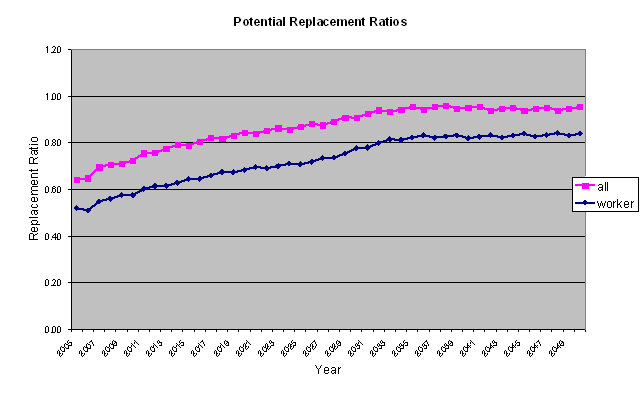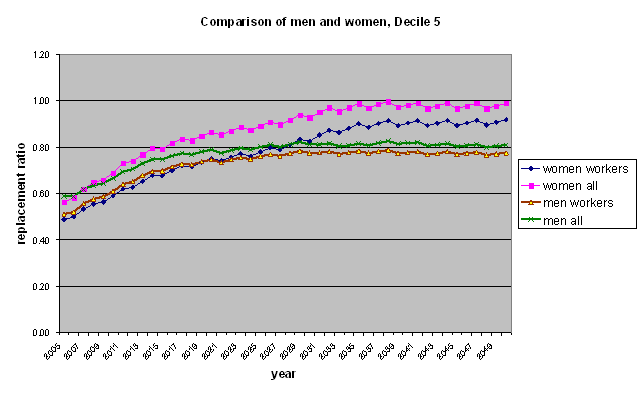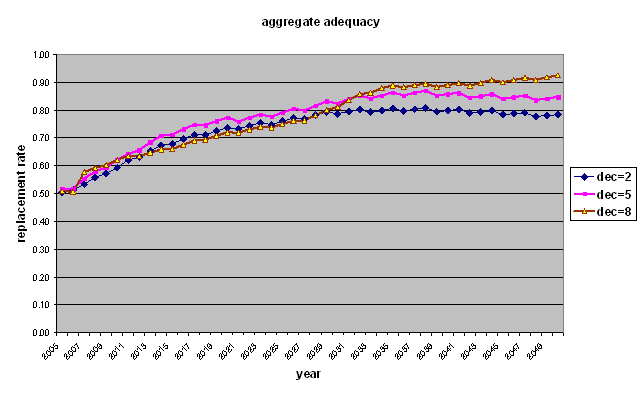For an analysis of potential replacement rates it seems appropriate to assume that assets are largely drawn down in an annuity pattern over the person’s or couple's retirement. This measures the potential afforded by the retirement income framework. In practice, given uncertainty as to their longevity, most prudent people won't achieve this and as an operational compromise we have assumed annuity drawdown of fixed interest deposits but only moderate drawdown of shares and allocated pensions, assuring some inheritance on average. Because of the increased incentive to take allocated pensions under the Better Super arrangements, a significant change over time in investment allocations at retirement is assumed, with allocated pensions becoming a much more popular way to utilise available funds at retirement. These assumed patterns together with a broad continuation of labour force and retirement trends are the basis of the aggregate results which follow.
Ratios of retirement expenditure over recent pre retirement expenditure are calculated for two groups: those who have had long term superannuation coverage, and the full population, adding in those who have had little or no superannuation coverage, including those self employed who have chosen not to contribute. For convenience we will call these groups ‘workers’ and ‘all’. The time analysis of aggregate replacement ratios for these two groups is shown in Chart 2 below.
Chart 2: Potential Aggregate Replacement Ratios – Workers and Full Population, (all deciles)

Replacement ratios are projected to rise significantly over time: in the case of workers from a little over 50 per cent currently to 70 per cent around 2020 and over 80 per cent by 20328. For the ‘all’ group the replacement ratios are estimated as already over 60 per cent and are projected to rise to over 80 per cent by 2016 on.
Gender
It is well established that women have markedly different labour force participation compared to men, with much longer periods out of the workforce, more part time work, and lower wages on average than men. All these patterns are built into the aggregate model together with projections which show a continuing increase in the work force participation of women. Also included are superannuation coverage and contribution rates for women. For women working as full time employees, coverage rates are slightly higher than those of men. However, given that a greater proportion of women are working part time, coverage for women employees overall at 91.8 per cent is lower than the corresponding 93.2 per cent rate for men (ABS, 2007). Chart 3 below shows relatively minor differences in the replacement ratios of women and men workers in the fifth income decile over the shorter term, with the women workers projected to have higher replacement ratios than men workers over the longer term. The maturing of the SG arrangements and of the co-contribution helps raise the replacement rates for women more than for men.
Of course these ratios are relative. In absolute terms the modelled pre retirement income of women workers in this decile is around 75 per cent of that of men, reflecting the composition of work undertaken and the much higher proportion of women working part time. Women also have significantly lower relative post retirement income from private sources. But age pension payments to both men and women are the same (for any given level of income or wealth), boosting the replacement ratios for women.
Chart 3: Potential Aggregate Replacement Ratios For Women

Initially the replacement rates for the ‘all women’ group is very similar to that of the ‘all men’ group. However the maturing of the SG arrangements and of the co-contribution, the continuing strong increase in workforce participation of women and the greater relative significance of the age pension for women leads to higher long term ratios for decile 5 women compared with men, for both the workers and all groups. It should also be noted that recent Census data shows that over 70% of people enter retirement as a member of a couple.
By Income Level
Also within the annuity drawdown framework it is interesting to analyse replacement ratios by income level which is done conveniently within RIMGROUP using the decile structure. This is done in Chart 4 below.
A number of interesting comparisons can be made. Firstly, the decile 5 ratios behave much the same way as the averages in Chart 2.
Chart 4: Potential Aggregate Replacement Ratios for Selected Deciles

The next comparison from Chart 4 is quite striking. The projected replacement rates for the deciles are quite close, perhaps surprisingly close. The replacement ratios for decile 8 are generally slightly higher than for decile 5 and decile 2, particularly in the long term and this may appear to contradict the standard hypothetical picture where replacement ratios drop as income rises (Table 1). There is no conflict, however, as this aggregate picture includes all forms of saving for the deciles, not just in superannuation, and importantly, also reflects the established pattern that actual superannuation contribution rates as a percentage of income rise with rising income (Rothman, 1996, Bingham 2003). Accordingly while SG only savings would give the replacement rate dropping as income rises, actual savings patterns do not.
The growing impact of the co-contribution is the likely explanation of deciles 2 and 5 overtaking decile 8 over the middle term. But as current policy is that the co-contribution is a fixed dollar amount, this effect becomes less significant over the long term. Future ad hoc changes to the maximum co-contribution level or taper ranges could change this result.
8 ‘Ripples’ in Charts 2, 3 and 4 arise because of assumed indexation of income tax scales at 3 yearly intervals.